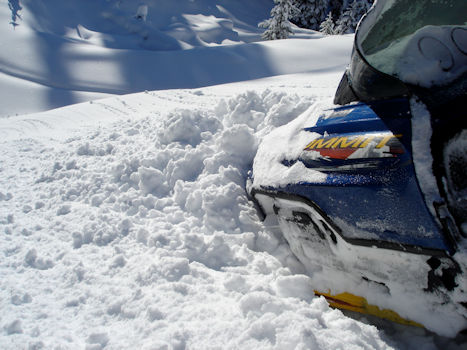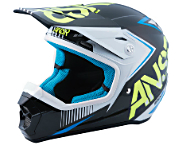© 2019 by Bill Uhl, ATV Expert Witness

EXAMPLES OF SNOWMOBILING DANGERS
Snowmobiling safety concerns can compel smart snowmobilers to build a snow bridge in late fall or early winter across a creek or wet area. If a snowmobile rider fords a creek during the winter, they can run into the following safety issues.
- If the trail is not ridden often or if a large snowfall occurs, the snowmobiler may discover a very deep hole in the snow that is kept open by flowing water or a wet area. Because it can be 4 to 5 feet down to the creek bank or water, a snowmobiler will have to stomp down the bank so he can get down to the bank (the water) at an angle that will allow him to cross.
- Before the operator can then cross, he’ll have to wade across the creek or get to the other side somehow so he can prepare his exit out of the creek. This means he’ll have to stomp down or dig out the snow again on the far shore or wet area because a snowmobile can only climb a bank at a certain angle.
- The driver must be aware that the rocks in the bottom of the creek or wet area provide very little traction to push the snowmobile forward up the far bank. Since rocks in the bottom of many creeks are smooth and covered with moss that makes them very slick, the driver will need to maintain speed. Momentum is essential if the snowmobile is to hit the far bank with enough force to propel the machine out of the creek far enough so the track can once again gain traction in the snow on the far bank.
- If the temperature isn’t right, water will freeze onto all parts of the snowmobile. Snow will stick to the bottom of the skis and wear rods. This is dangerous because the snowmobile can stop in its tracks. With the snow stuck to the bottom of the skies it’s like pulling on only the front-wheel brakes of another type of vehicle like an ATV. Which causes the track to dig into the snow because the skies are not sliding and now you are also stuck in the snow.
- All in all, it can be risky and life threatening if the air temperature is low (like around 0 degrees) and the driver gets wet with no way to dry himself.
- Climbing up the far creek bank while the track is spinning can erode the bank if you spin down to the dirt when you exit the creek. This exit will channel water in the spring time.
USE A BETTER, SAFER SNOWMOBILING SOLUTION
If snowmobilers ride in the area often during the winter, they can prep their riding area in late fall or early winter. You can significantly increase your snowmobiling safety by building temporary snow bridges.
- When you maintain your snowmobile routes in late fall and early winter, take the time to build temporary snow bridges on the downhill side of the route out of the fallen logs and brush that has been cut away from the trail bed and placed to the downhill side of the trail. (Bridge building materials are easy to find during that time of year). It does not take much material to gain the height you need so the low water can flow underneath your temporary bridge of old logs, crisscross sticks and brush to hold the snow off the water or wet area that is often just inches from the water or wet ground when it’s built. (In some wet areas, you only need to lay some brush on the ground to hold the snow up just a few inches.) Later in the winter, your snow bridge can be 6 or 7 feet above the water or wet area. What I’m recommending eliminates the danger of getting stuck in the creek or getting wet, reducing danger and thereby increasing your safety.
- Don’t skimp on the width of your bridge. When spring comes, the side of the bridge that faces the sun will start to melt before the rest of it does. This means you’ll need space to maneuver on top of the bridge.
- How stout the bridge will need to be to carry the weight of the snowmobile, rider and the 6 or 7 feet of compacted snow that’s on top of the bridge will depend on how much water will be flowing under your bridge and the height of the water.
- If the stream is flowing fast, you’ll need to remove the bridge in the spring so water can flow down the creek without obstructions. Just stack the old bridge materials out of the way for next year’s bridge.
- If the bridge is just crossing a wet area or a seep of water, you can leave the bridge in place. Vegetation will grow through the sticks and camouflage the area. The bridge you create can actually improve each year! In many instances, only you will know the snow bridge exists because it blends into the area so well that it looks like a natural crossing. I have had bridges last for 5 or 6 years, requiring only minor adjustments from year to year. Because you’re not riding up and down banks, the soil will not be disturbed. This means you’re preserving the dirt crossing for use during the rest of the year.
Watch the short video about creating a safe snowmobile creek-crossing bridge. Crossing without a correct safety bridge can be so dangerous that you may be risking an accident, injury or even death. Even a temporary bridge can solve many hazards you don’t want be challenged by. As you watch the video, think about how the bridge will look when the snow covering the surrounding area melts in the spring. Notice the crisscross sticks on top of some logs. Also notice how the sunny side has started to melt out. Observe how the logs span the gap of a drainage ditch alongside a trail that has very steep sides and is impossible to cross without the temporary bridge. Consider how this fun, relatively simple process can create safe access to a recreational area on the other side.
Enjoy your time in the snow! Just make sure you go prepared for the unexpected, including a possible night out when you least expect it.
NOTE: This article is not intended to be all inclusive. It is designed to provide a foundation for the reader to learn from.
Bill Uhl is a Safety Trainer and Court-Qualified Expert Witness for cases involving all-terrain vehicles (ATVs), utility vehicles (UTVs / side by sides), ROVs, snowmobiles, motorcycle dirt bikes, dual sport bikes and off-road bicycles. Uhl has completed over 75 cases while serving as an Expert Witness, including trial testimony. Click here now for more information.


